Doonbeg – Playing Trump’s Irish Fantasy
This is my fifth review of golf courses in southwest Ireland based on a trip there in September 2019 with Barry McGuigan’s former company Golf NI. We started out with the fabulous Old Head of Kinsale followed by Arnold Palmer’s magnificent course at Tralee. Unfortunately at our third course, Waterville the weather was so bad some people didn’t even finish it, so there is no review on what is really a must play course in the area. Our fourth course was Tom Watson’s darling, Ballybunion which has some really great holes, but some very weak ones as well. The last course was the quirky, but wonderful Lahinch with the world’s weirdest par three courtesy of Old Tom Morris. Today we’ve moved half an hour down the coast to the tiny community of Doonbeg where Donald Trump has his Trump International Golf Links.
History of Doonbeg
Unlike Lahinch. Waterville and Ballybunion, Doonbeg does not have a long history and in fact only dates from 2002 when the same group that owns the courses at Kiawah Island, South Carolina purchased 377 acres of shorefront property with great rolling grass covered sand dunes. The property was perfect for building one of the few new links courses in the world. They hired Greg Norman to design the course, the only one he has done in Great Britain and Ireland. Norman’s philosophy was to route the holes around the natural depressions between the dunes and to disturb as little ground as possible. At the same time the developers built a huge manor house with an inner courtyard that housed restaurants, accommodations and the pro shop, as well as a series of bungalows well away from the main lodge where we stayed.
This is the view of the clubhouse I took from the 18th green.
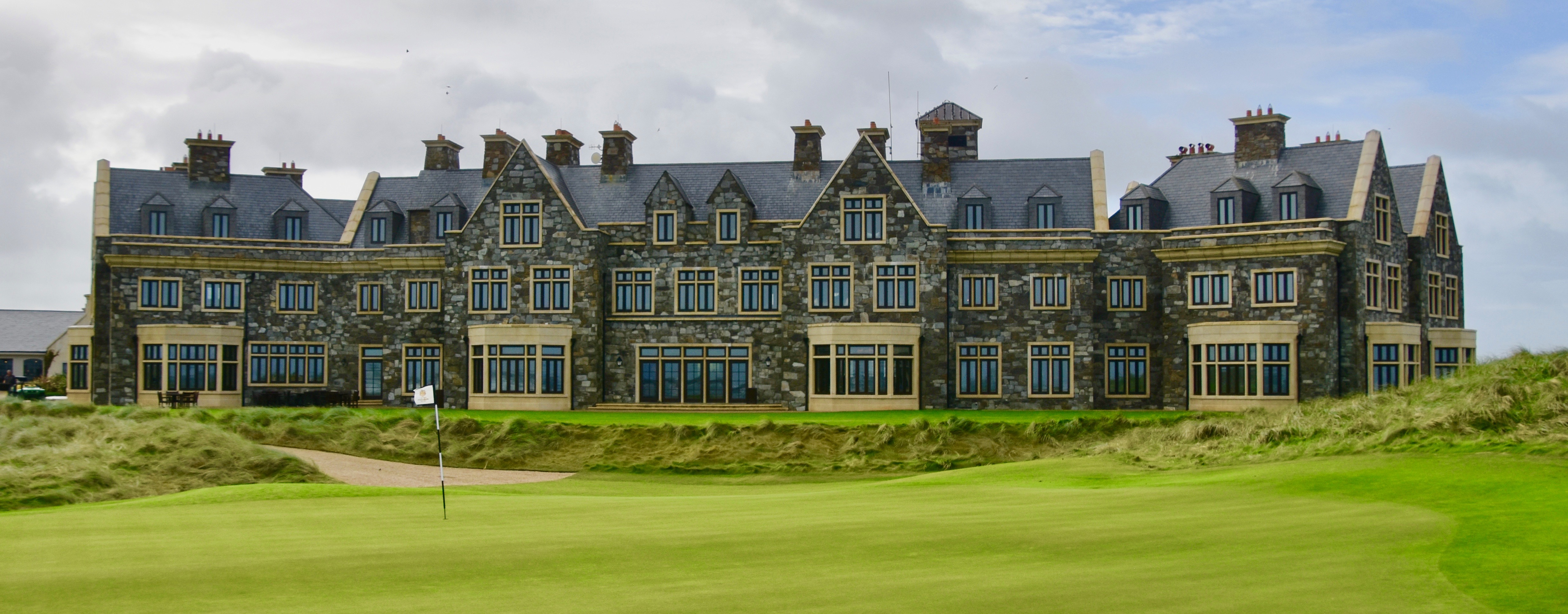
This is what the whole complex looks like from the air. You can see that it is massive.

The course turned out great, but typical of many of Greg Norman’s courses, ordinary people found it just too damn hard. That reputation, combined with the 2008 recession led to the whole enterprise being a huge money loser and in 2014 Trump snapped it up for a reported fraction of what it cost the Kiawah partners to build. The first thing he did of course was to rename it after himself as if somehow that would be a cure all. The word Doonbeg appears in tiny letters underneath the blaring Trump International. More sensibly he hired Martin Hawtree to do a redesign to make it more playable for the middle handicap players who make up the vast majority of golfers who go on these golf junkets. Hawtree also tinkered with Lahinch, Ballybunion, Portmarnock and Royal Birkdale and was principal designer at Trump’s Scottish links course.
The other thing Trump did was to get into a fight with the locals by wanting to build, guess what – a wall. In order to stop Mother Nature from making natural changes to the dunes as she is wont to do, Trump wanted a wall to stop her. He lost, which he blamed on unnecessary European Union environmental regulations and some people think that he still holds a grudge against the E.U. C’mon man, Donald Trump hold a grudge? He’s too big for that, or is he?
So here we are on a windy and partially cloudy day ready to play Doonbeg. We have elected to play the white’s which are 5,992 yards. Our caddy is Michael O’Loingsigh which is the Gaelic spelling of O’Leary. I have noticed that quite a number of young people in Ireland are reverting to the traditional spelling of their surnames, forgoing the phonetic Anglicized version. That’s me on the left with my buddy Chuck Johnstone on the right.
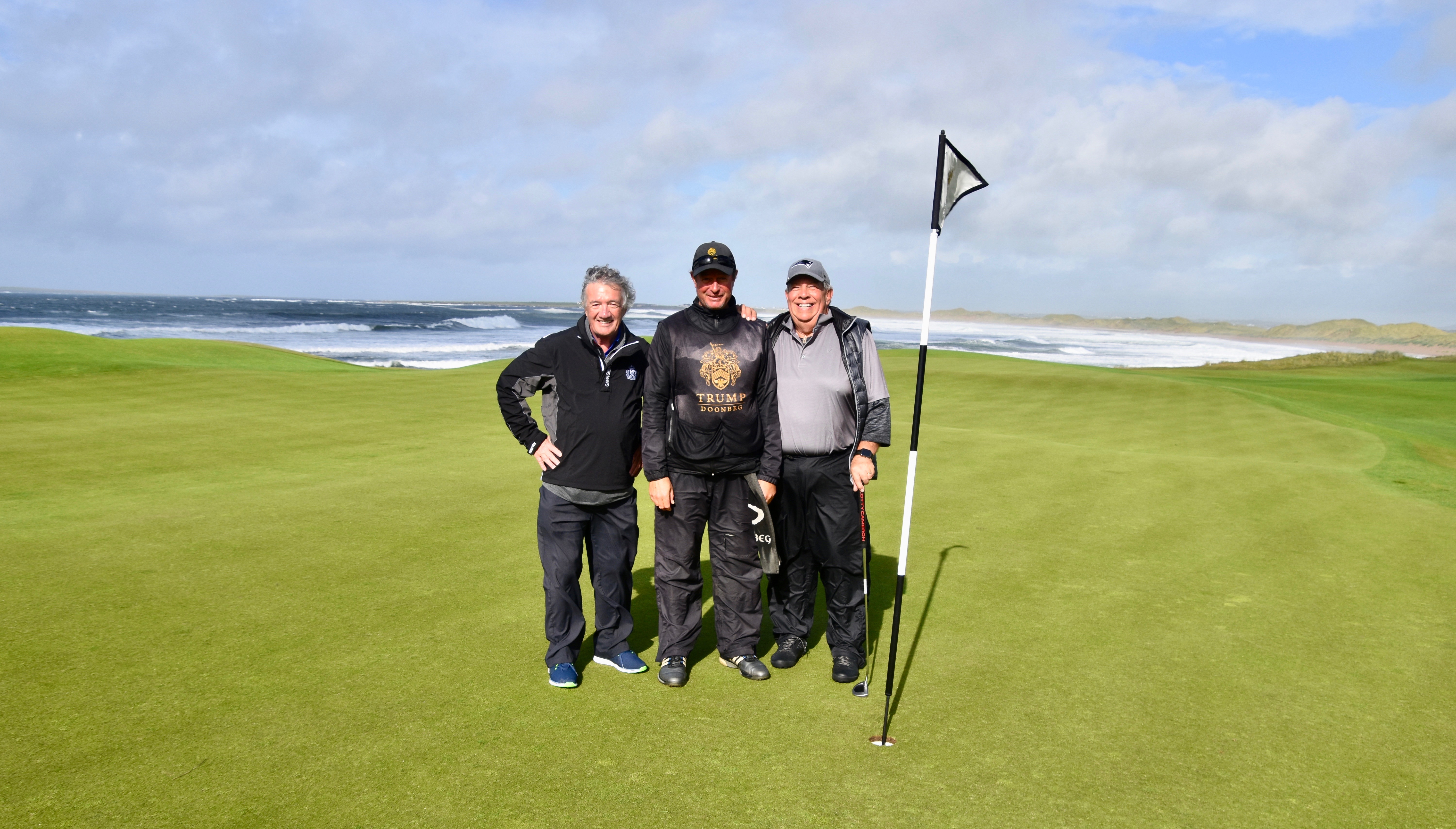
Despite being a ‘stable genius’ nobody told Trump that it would be a good idea to have a map of the course on his web site. Many Irish courses also name their holes and have interesting stories behind the names, but not here. There are flyovers, but without any accompanying verbal description so you’ll have to rely totally on my photos and recollection.
Unfortunately, Trump has succumbed to the American allure for golf carts or buggies as they are called here and a few golfers were using them, but not many. I’m not against using golf carts and in fact usually do, but somehow they just don’t belong on links courses. You can also rent a pull cart or trolley which most of us took advantage of.
Doonbeg is a bit unusual in that there are five par threes and fives instead of the usual four of each.
No. 1 – 510 Yard Par 5

Not many courses start with a par five, but in this case this is an absolutely great starting hole and typifies what is about to come. There is a generous landing area with high dunes down both sides all the way to a green that is tucked in a cove surrounded by a massive dune.
Assuming you are not a monster driver who can reach this in two, this is probably about what your approach shot will look like. Lots of traps and if you go long and get into that shit behind the green, forget it.
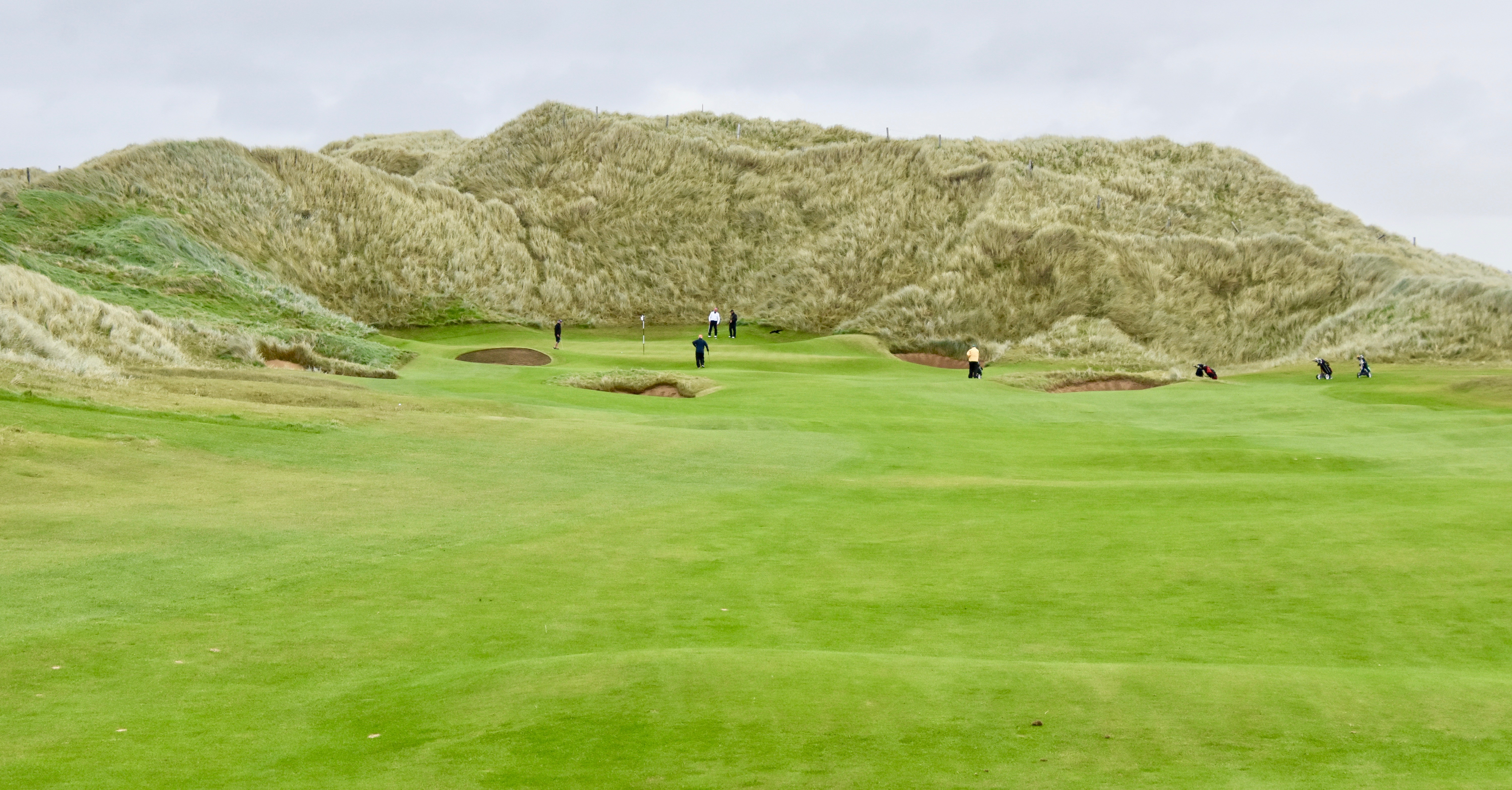
One thing that was noteworthy about Doonbeg was the immaculate condition of the fairways and greens. Hawtree completely redid all of the Norman greens turning them into what one other writer called ‘wrinkled potato chips’. I couldn’t say that they were unduly difficult to manage, especially with an excellent caddie reading them for you.
No. 2 – 389 Yard Par 4
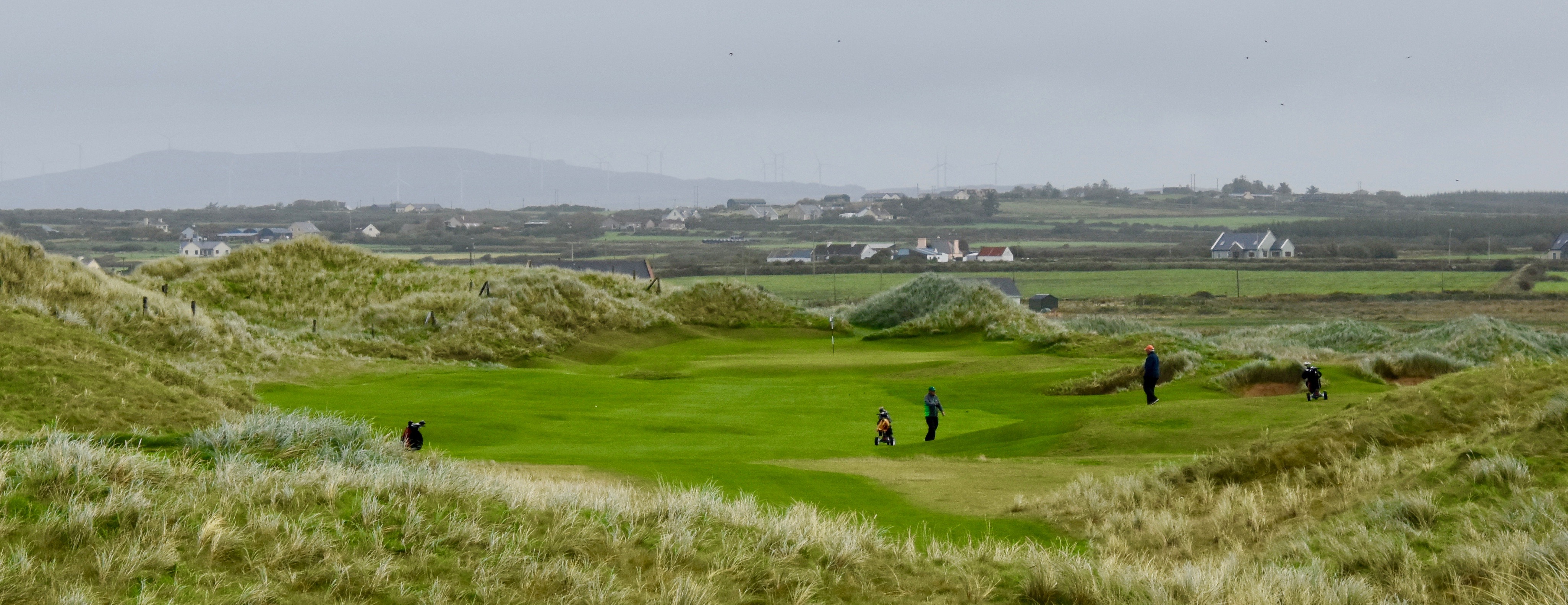
The first par four is another hole with dunes on both sides and has a fairly long carry from tee to fairway. For now, we are playing downwind which will be the case for most of the front nine, but that means a headwind coming home. You’ll note the bunkers on the right that have ‘eyebrows’ which are designed to help keep the shape of the bunker in windy areas. However, it is a bastard if you get out of the bunker and into the long grass that makes up the eyebrow, so going out sideways is sometimes the more sensible play. Overall another nice starting hole.
No. 3 – 290 Yard Par 4
For some reason I forgot to take a picture of this very short par four which is the easiest on the front nine. It requires just a five wood or even five iron off the tee and then a precise second shot to a green guarded by dunes on three sides.
No. 4 – 580- Yard Par 5
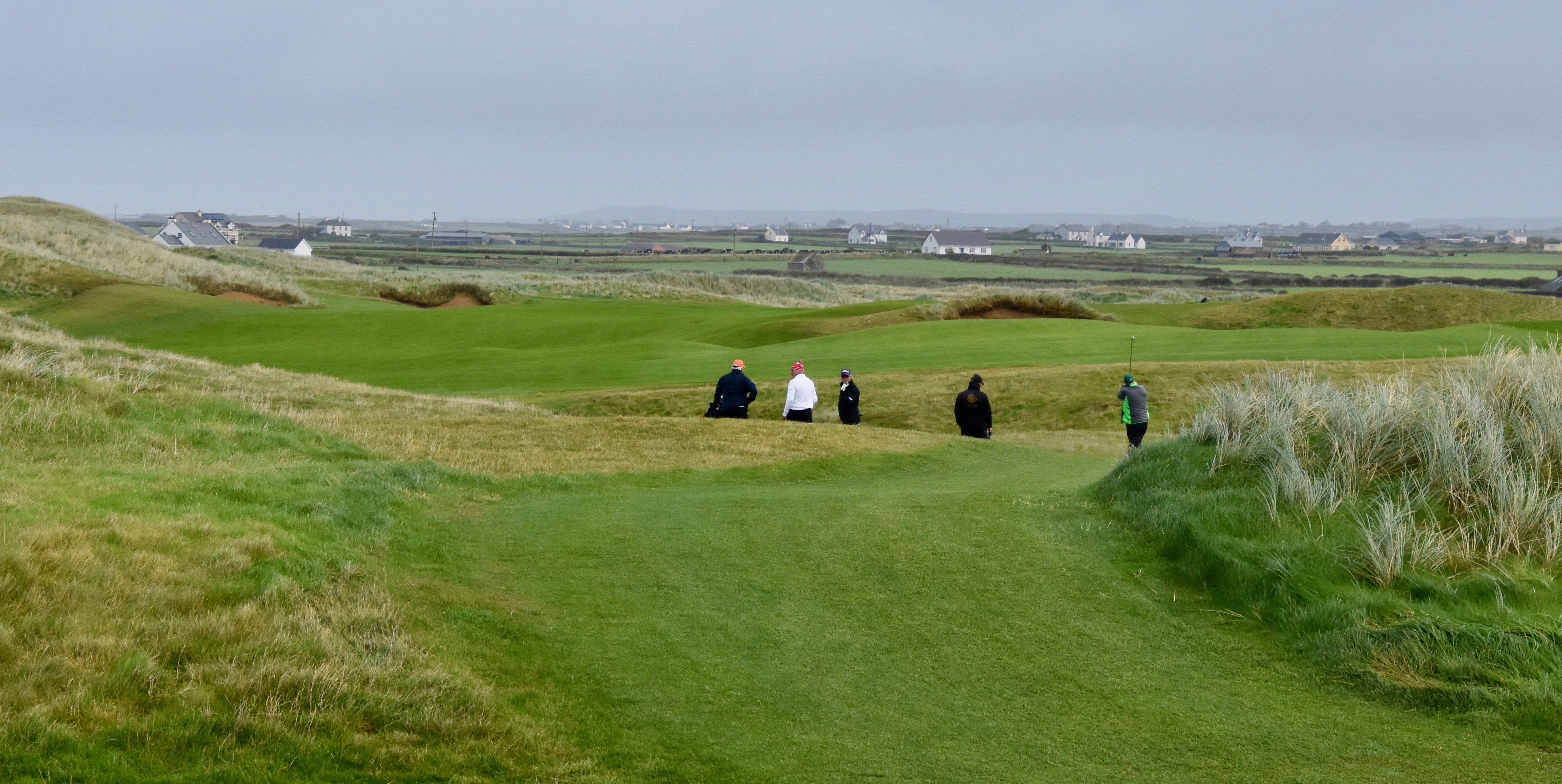
No that’s not a misprint, this hole really is almost 600 yards from the geezer’s tees and by far the longest we played on this entire trip. It’s the #1 stroke hole and it just goes on and on and on. Not a great golf hole in my opinion. You don’t give a guy a break with a teensy par four and follow it up with a kick in the nuts like this hole.
No. 5 – 266 Yard Par 4
Apparently Norman or maybe Hawtree felt contrite after the last hole because they now throw two more baby par fours at you. This one features a long carry to a narrow fairway which leaves you this view for your approach shot.
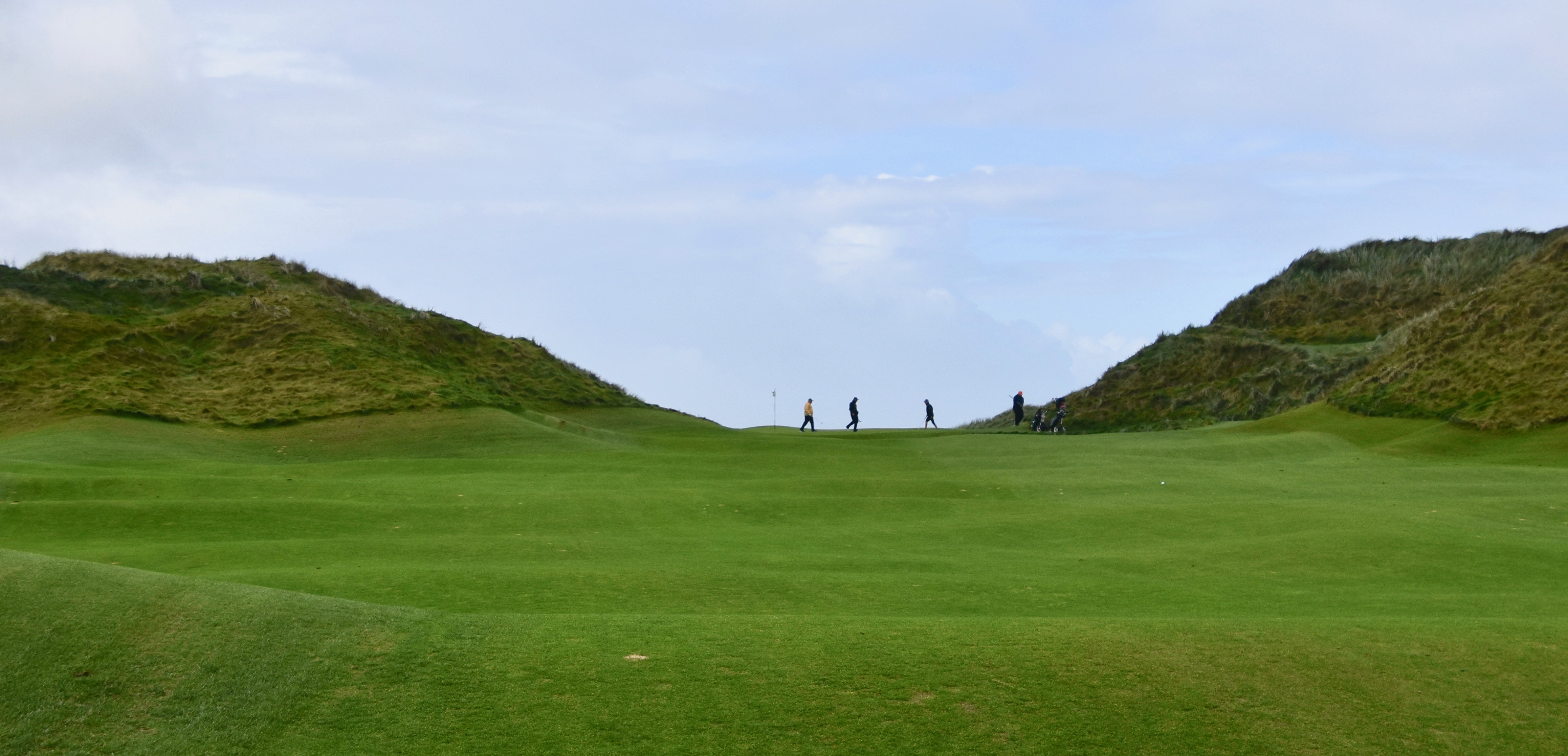
What you cannot see is that between the green and the crest of the hill there is a huge depression that is really a dry waste bunker. Thank God for Michael letting us know or else you would be tempted to maybe try a bump and run here which would end in disaster. This hole has a major crosswind as well since it cuts its way perpendicular to the coast and from the green you get your first good look at Doughmore Bay and its magnificent wild beach.
No. 6 – 284 Yard Par 4

In my opinion this is the second of the great holes on the front nine. I mean this is what links golf is supposed to be all about – wind, water, ridiculous fescue, pot bunkers with a narrow stretch of fairway in between. It plays downwind so you can hit something reasonable off the tee and still have a short iron in to a narrow green that surprisingly has no green side bunkers.
This is the view looking back from the 6th green. Not a soul on the beach.
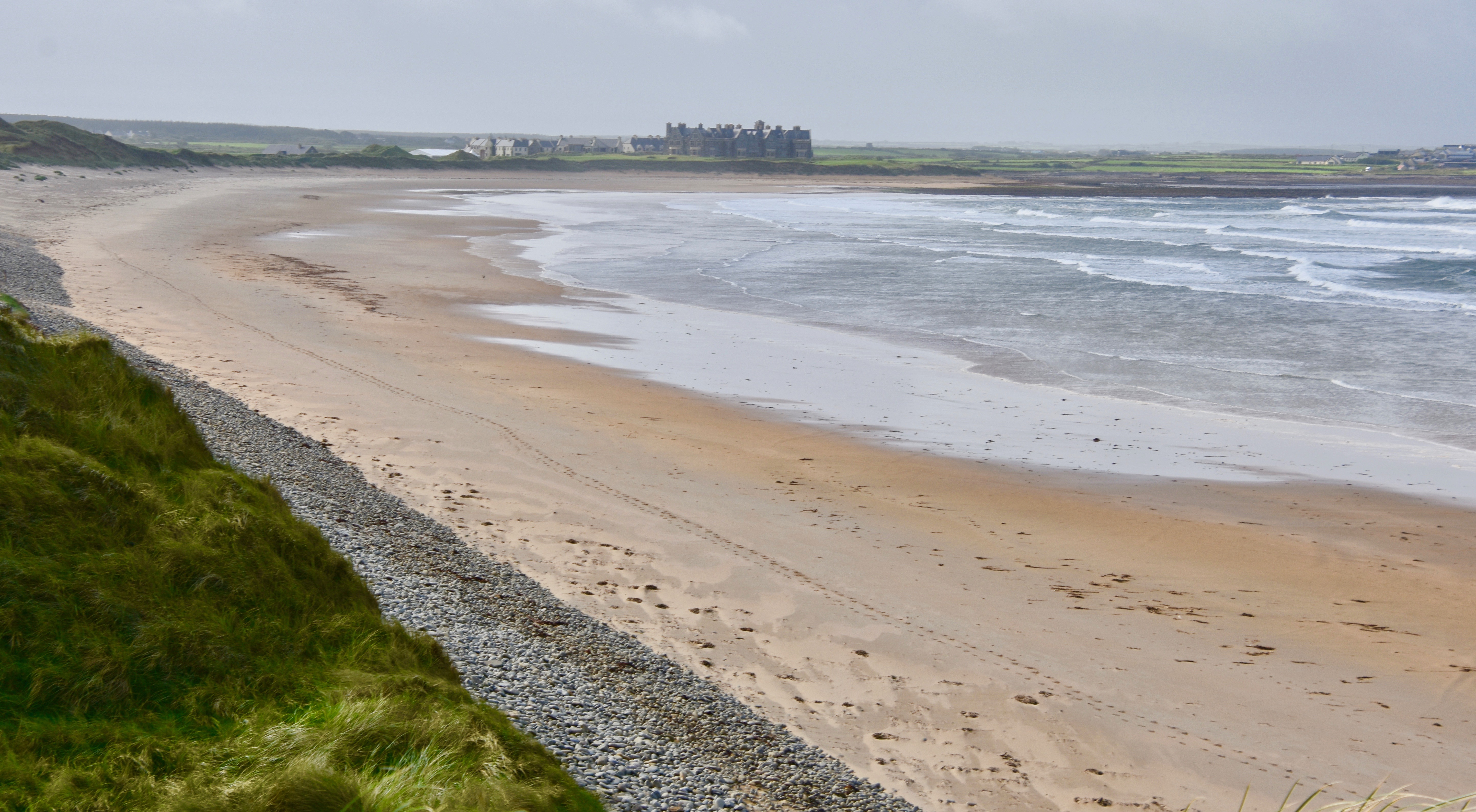
No. 7 – 183 Yard Par 3
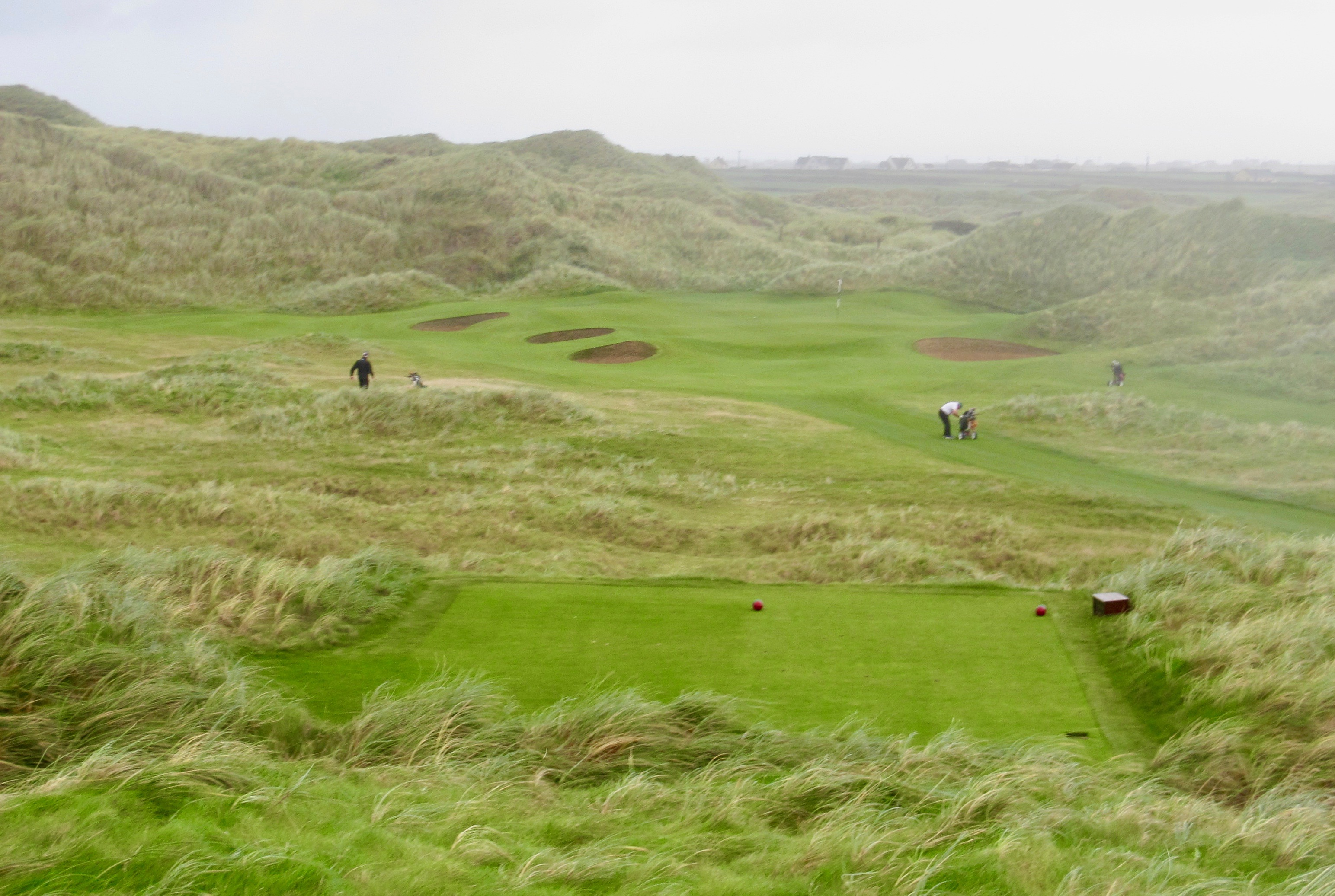
After that brief glimpse of the sea the course turns away and we finally get to a par three and it’s a beauty. The tee is considerably raised and the hole is surrounded entirely by dunes on all sides. Since it plays downwind the best shot will land short and roll on if you can avoid the bunkers on each side.
No. 8 – 514 Yard Par 5
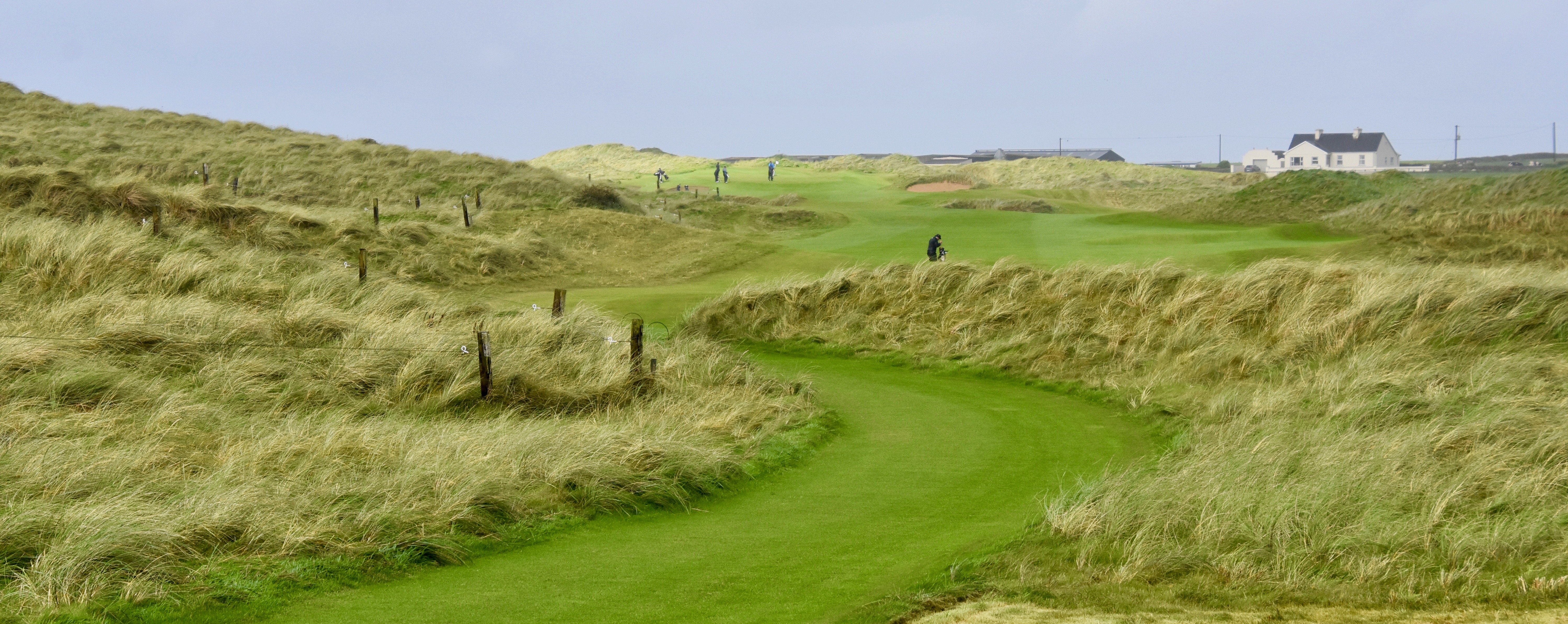
The third par 5 on the front is best exemplified by that mown path as it seems to twist and turn as it makes its way down to a very difficult third shot where everything rolls away into the three bunkers on the left of the green. It’s more of an optical illusion creating by dunes that cut down the fairway width in at least two places to not much more than a few yards. If you’ve managed to avoid the bunkers up until now, you will probably get a chance to experience them on this hole. By now, on our sixth course of the trip, most of us are getting pretty adept at getting out on the first try. It also helps to have a caddie like Michael who makes sure you swing through and have your club face almost parallel to the sand on contact.
This is likely to be your third shot on No. 8 and as you can see, a lot can go wrong.
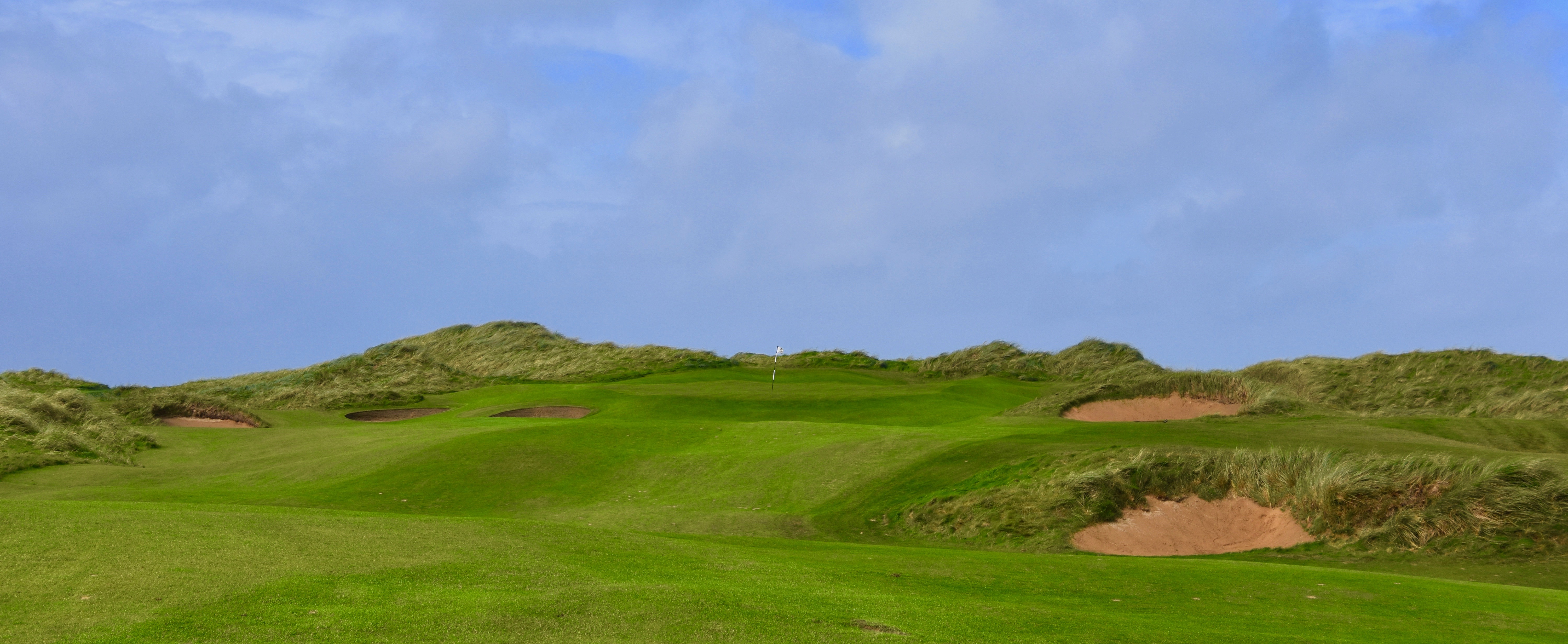
It’s interesting that the three most difficult holes on the front nine are all par fives.
No. 9 – 138 Yard Par 3
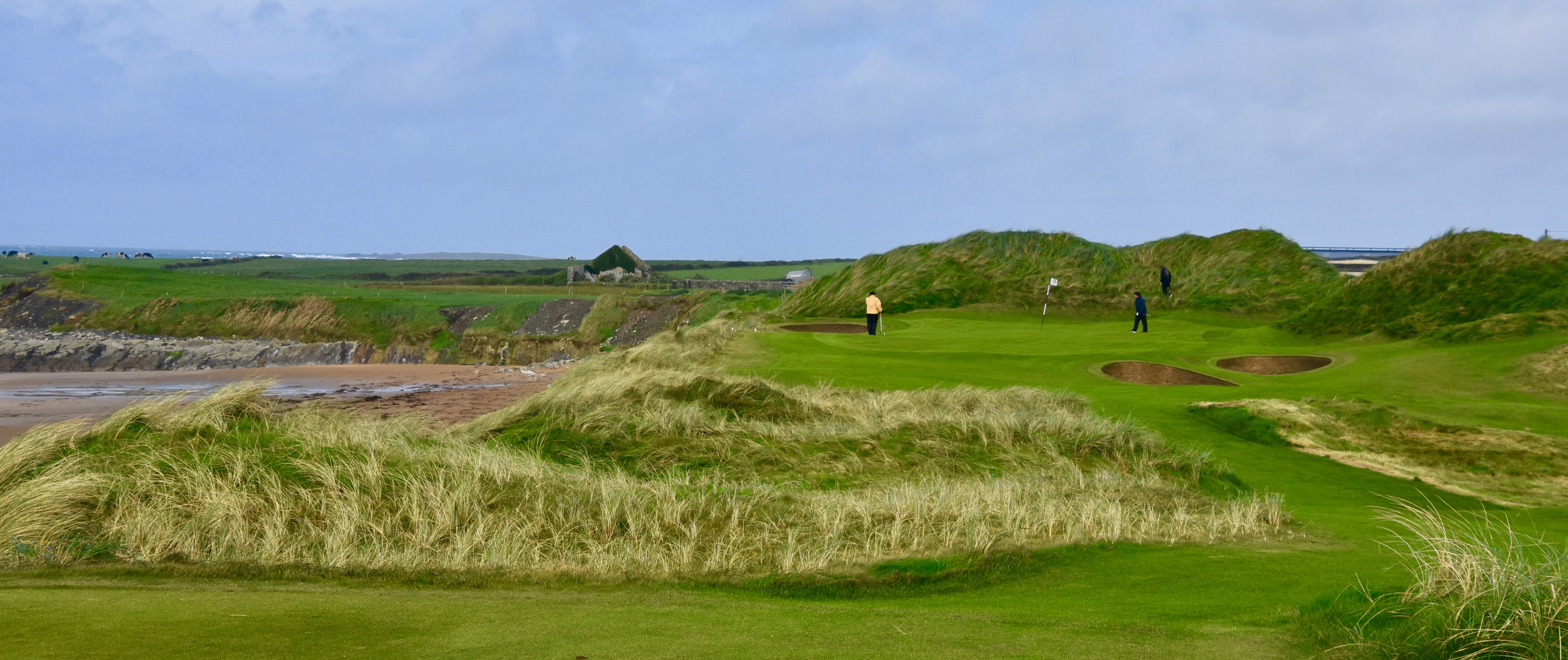
You’re back to the ocean on this very short par three that takes you to the furthest point away from the clubhouse on the course. The green on this hole is huge so even though it’s very short you could be facing a monster putt.
As is typical on links courses there is no return to the clubhouse after nine, in fact you couldn’t be further away.
No. 10 – 508 Yard Par Five
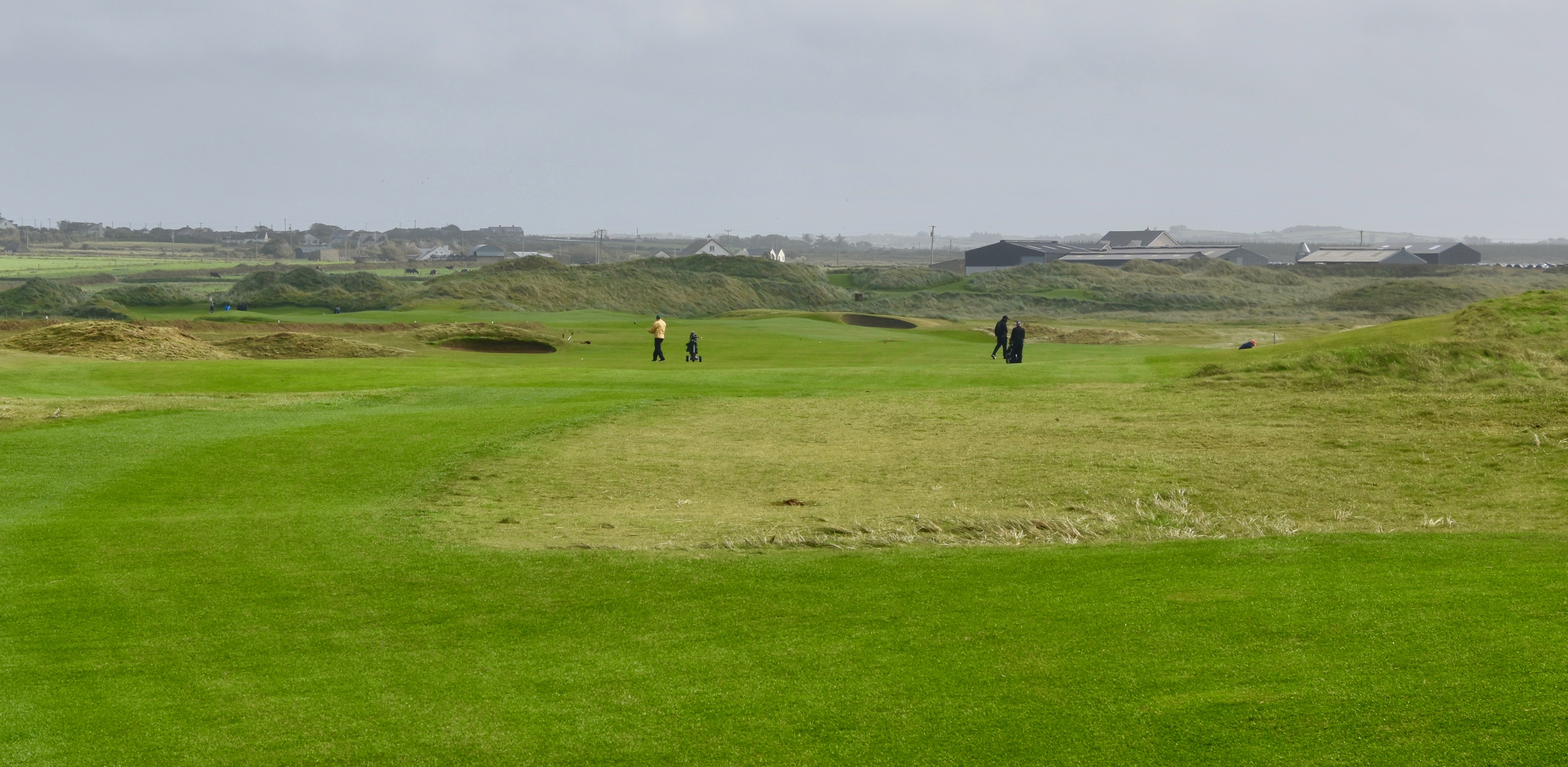
Yet another par five, albeit a relatively short one. It heads inland and you might see cows grazing on the left side. The real trouble on this hole comes on the second and third shots. About two thirds of the way down the fairway a Carnoustie like burn bisects the hole and then runs down the entire left side. On the other side of the burn the fairway gets extremely narrow making for a difficult third shot.
No. 11 – 142 Yard Par Three
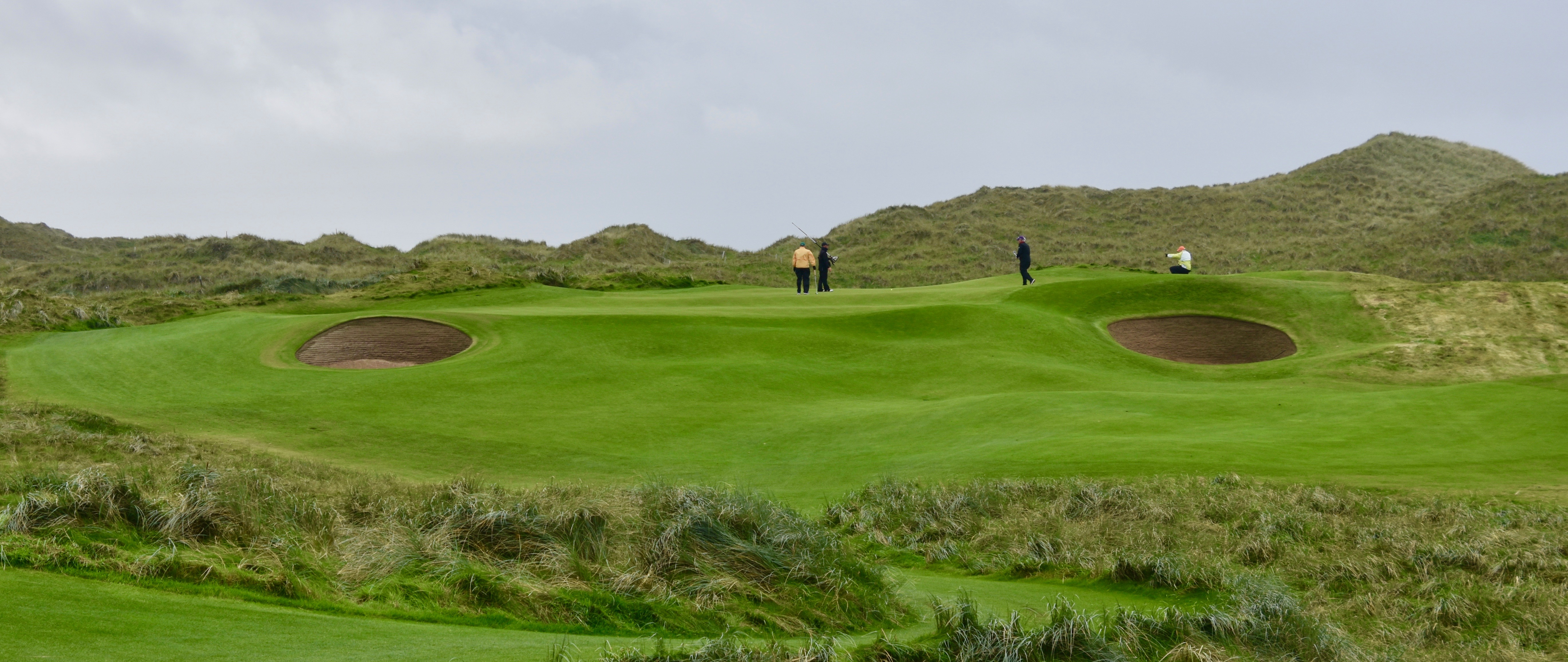
This is kind of a hohum par three that plays to a considerably elevated green. The biggest danger is those two very deep bunkers.
No. 12 – 383 Yard Par 4
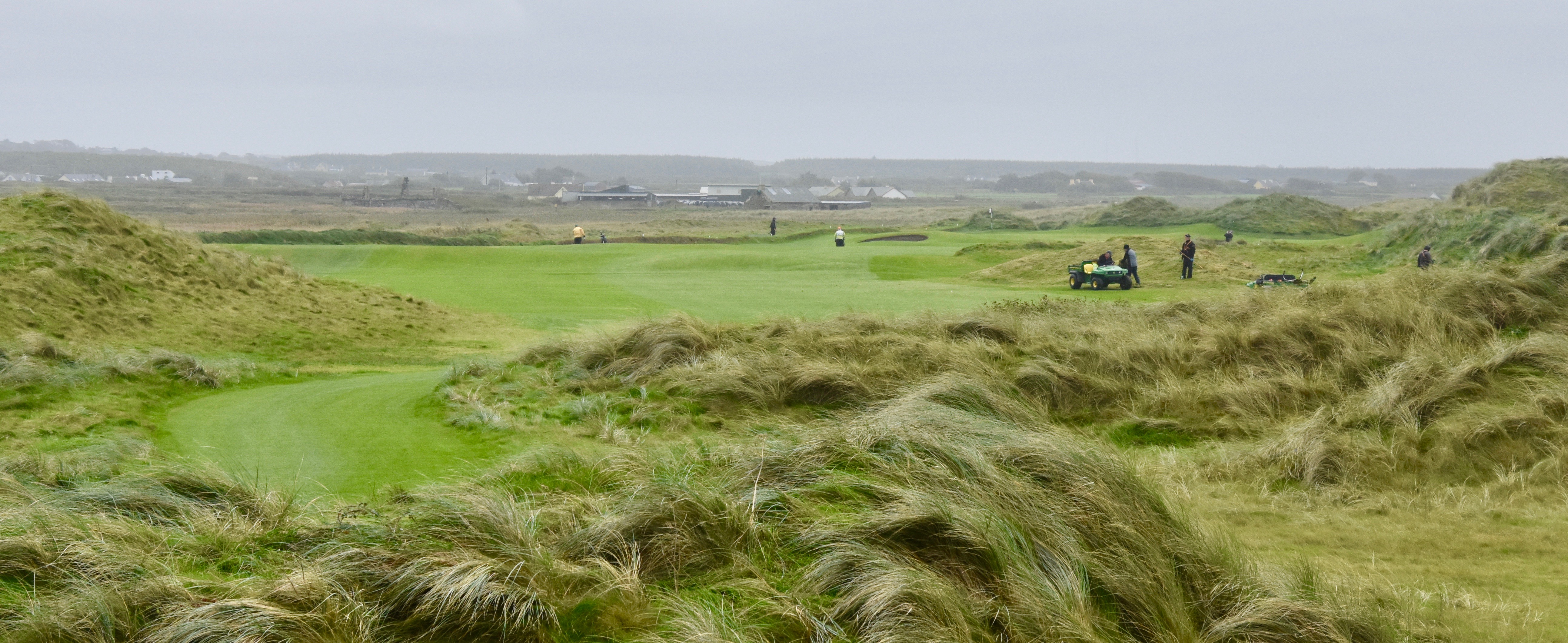
Only the second ‘normal’ length par four in the first dozen holes this hole is also pretty ordinary as it plays as a slight dogleg right to a green that does fit that description of a wrinkled potato chip.
No. 13 – 450 Yard Par 5
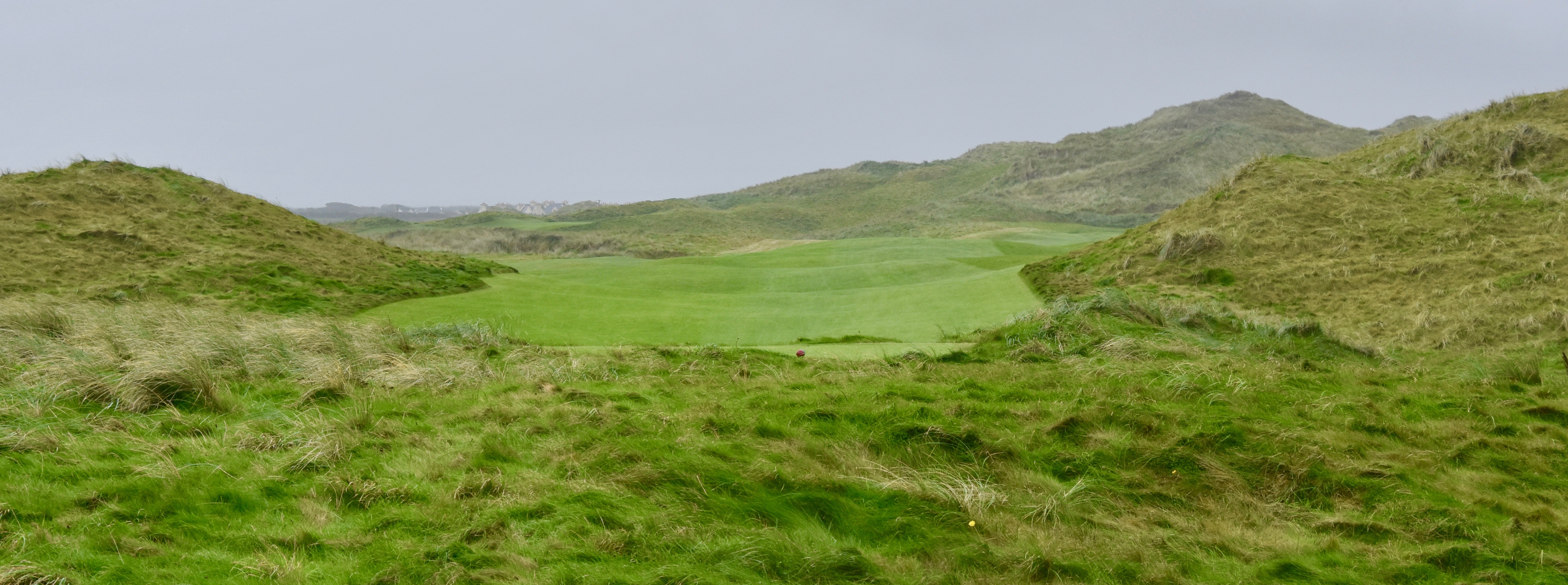
Finally a short par five, the last on the course and one with a lot of character that winds its way back to the ocean. The short length is deceptive as this is probably the narrowest fairway on the course. The green is tucked at an almost ninety degree angle to the right and is considerably uphill. On top of that it’s protected by seven bunkers so that going for it in two is really not an option. Unlike the first four par fives which are rated the four toughest holes on the course, this one is the 16th rated. If you play it sensibly with a wood off the tee and then an iron to the foot of the hill followed by a wedge this is not a hard hole. But then again, how many golfers play sensibly? Not many in my experience.
No. 14 – 132 Yard Par 3
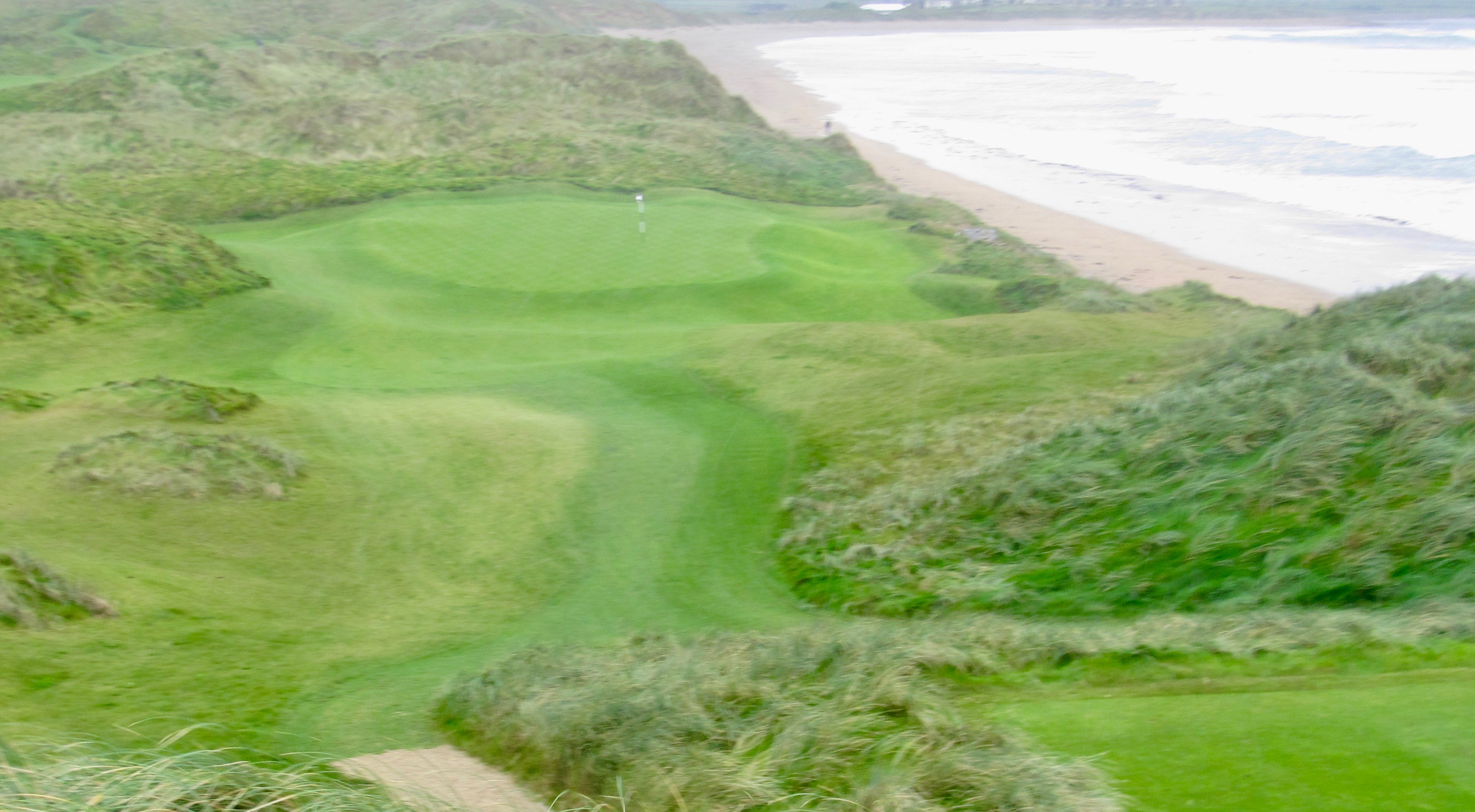
This short par three is the easiest hole on the course and easily one of the prettiest. It’s very much downhill and into the wind so if you pick the right club the wind should let it drop and stop for the best birdie chance at Doonbeg.
You might notice that the picture above is not that clear. Just after finishing this hole we got hit with a squall which forced us to lay up – literally. Instead of gorillas in the mist, Michael dubbed us the gorillas in the dunes.
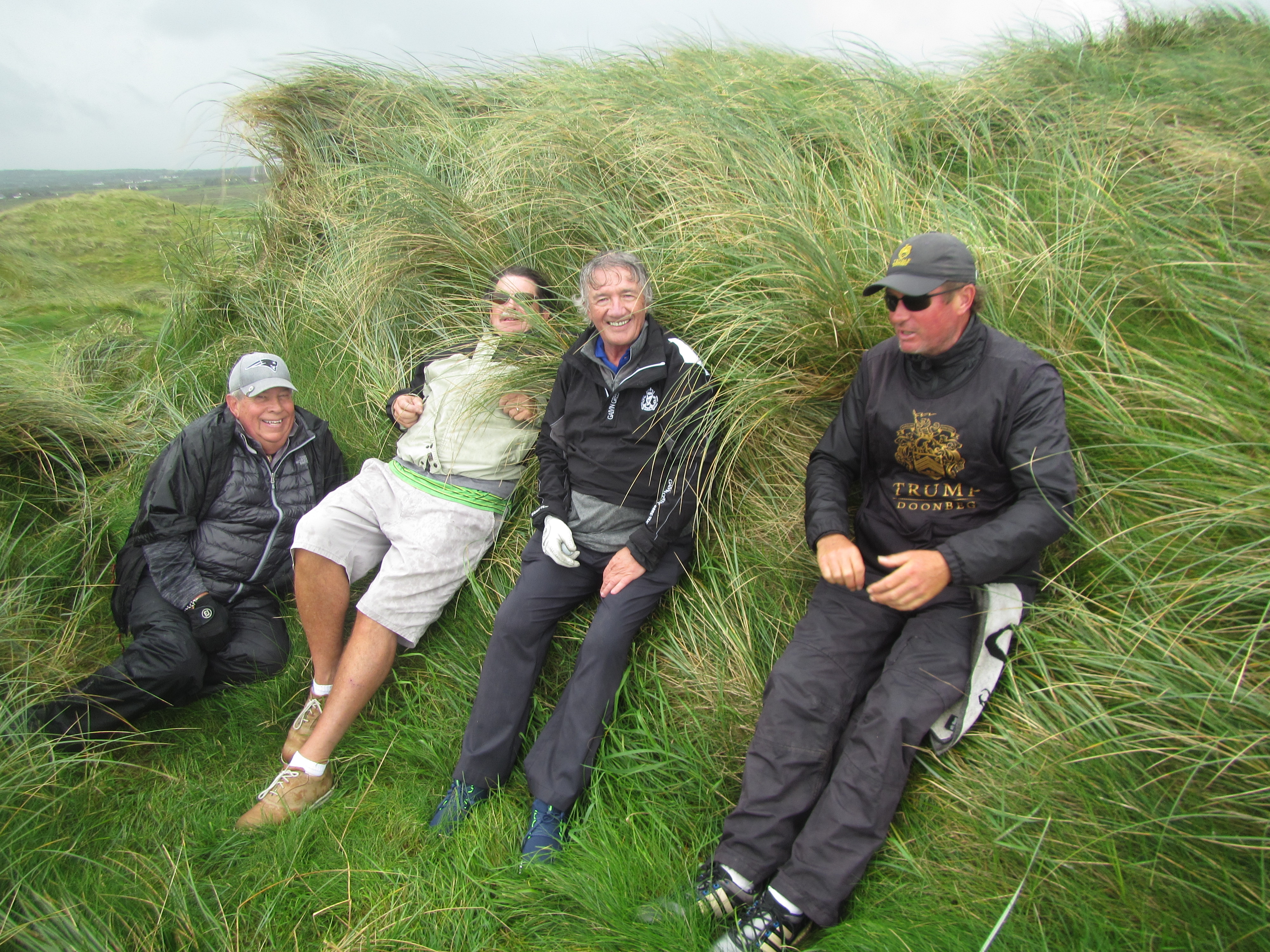
No. 15 – 327 Yard Par 4
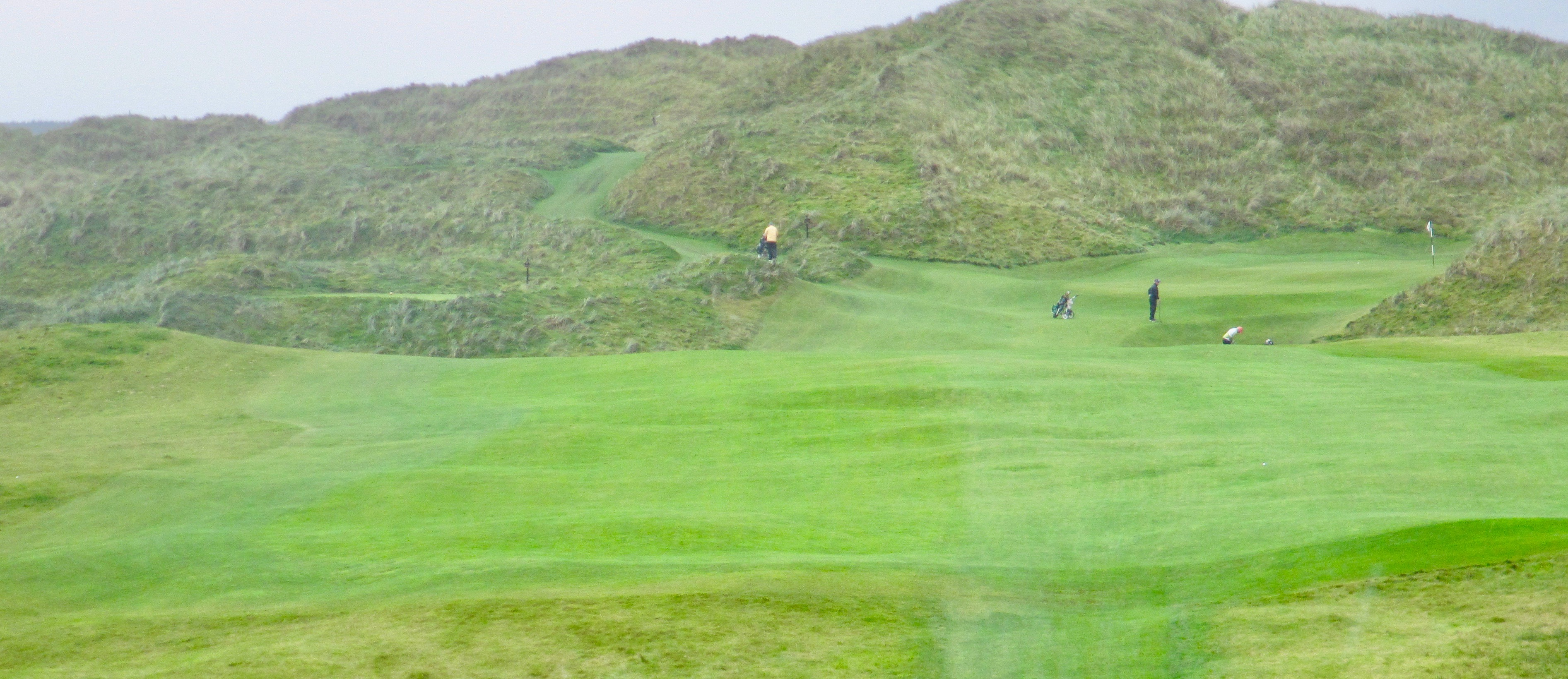
Another short, but very good par four that has the green tucked into the dunes very much like the first hole, but in a much more confined area. This was probably my favourite par four at Doonbeg. Even though there is a generous landing area off the tee, the second shot is no gimme.
No. 16 – 175 Yard Par 3
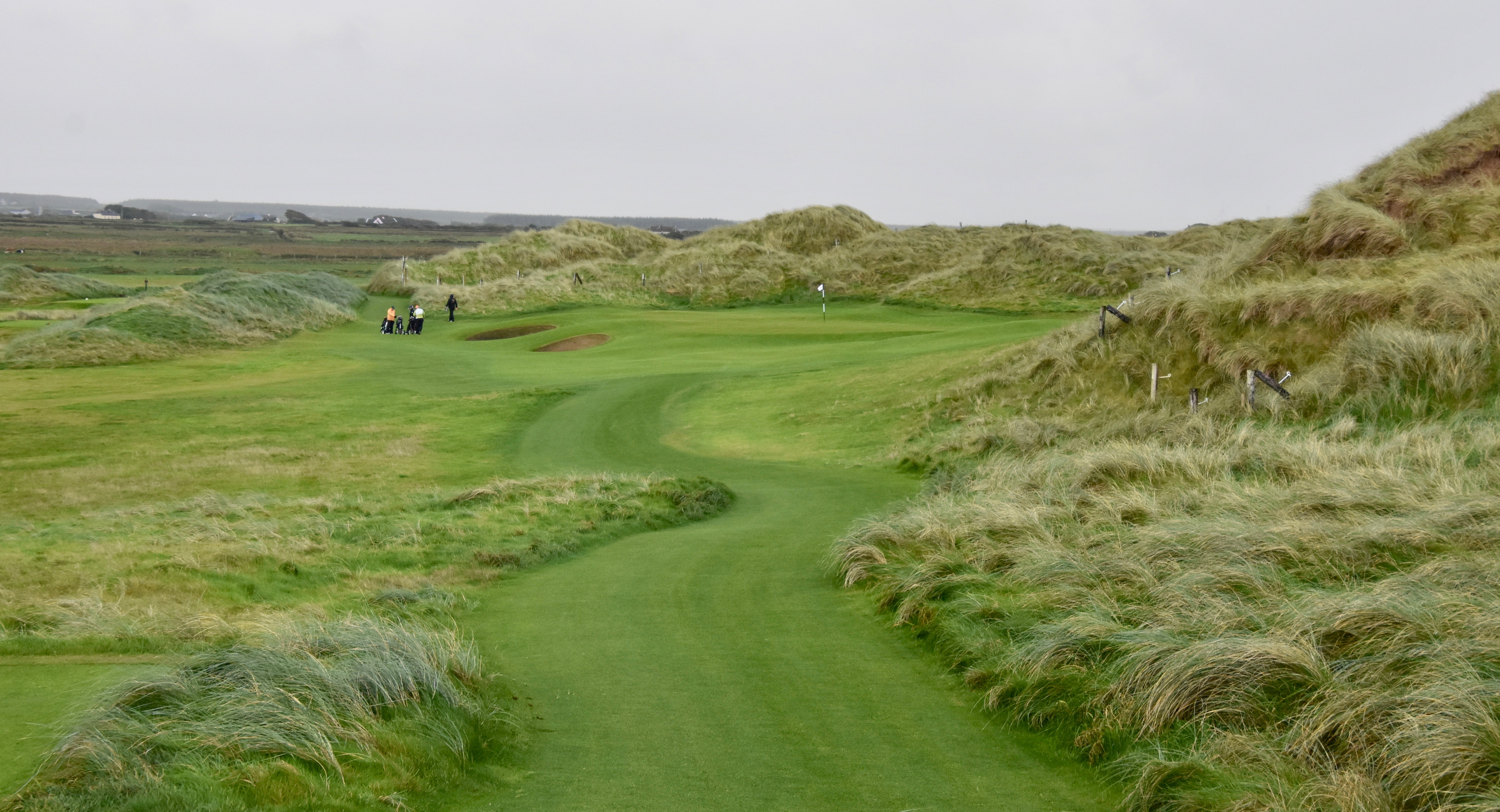
A very tough par three if you hit the ball from right to left and a great hole if you ball flight is the opposite. A good, but not great last par three at Doonbeg.
No. 17 – 374 Yard Par 4

Rated the second toughest hole on the course, I really couldn’t figure out why. The entrance road runs down the left side, but as you can see, this must be the widest fairway on the course. From this hole you can get a decent view of just how huuuuge the Doonbeg complex is.
No. 18 – 347 Yard Par 4
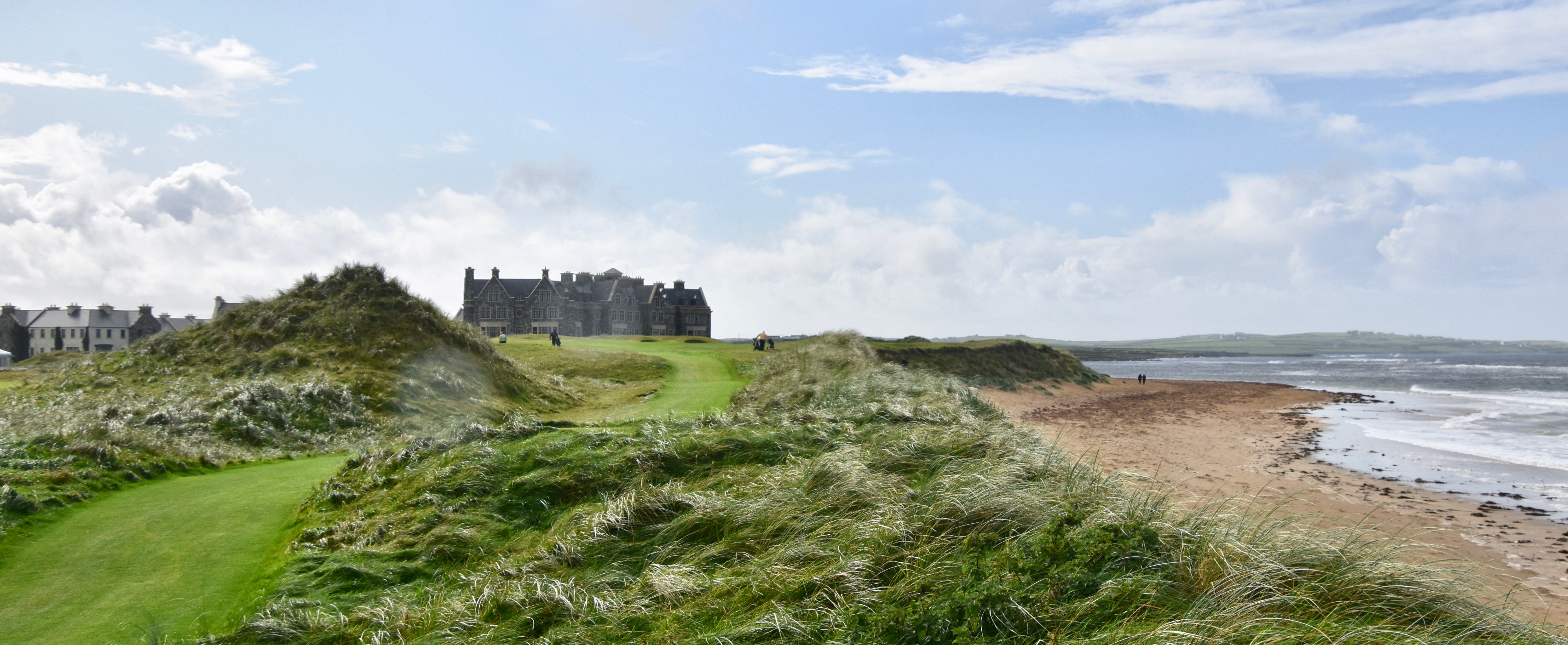
I would have to call this the signature hole at Doonbeg. The combination of the beach on one side and the manorial clubhouse make it very memorable. It’s not a hard hole despite this look from the tee box as everything opens up about a 100 yards out giving this view for the approach shot.
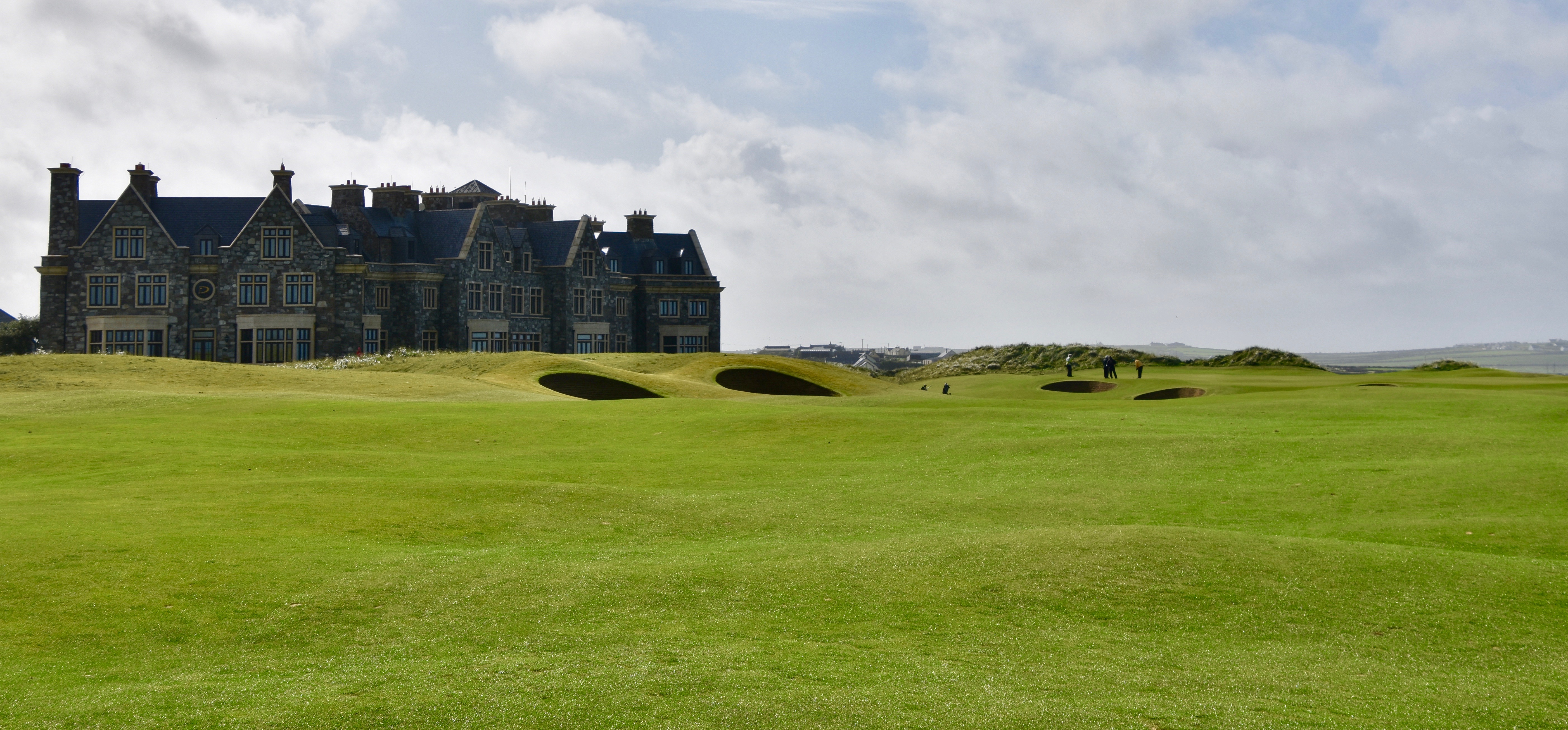
Once you get to the green you have this view of Droughmore Bay looking north.

And this view looking south towards the village of Doonbeg.
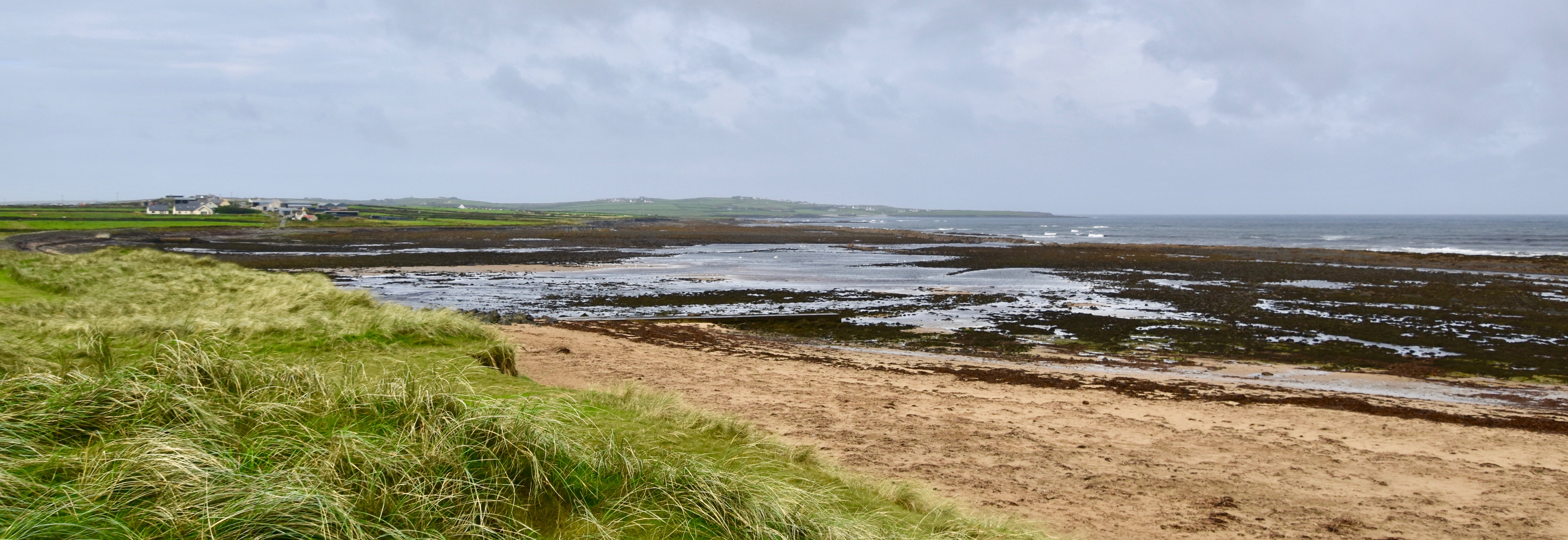
If Doonbeg was the only course you played in Ireland, I cannot imagine you would not be impressed. Ranking it against the other courses we played I think it comes out just a bit below, but not by much.
What else is there to say about this place? Well it definitely has the atmosphere of an exclusive private club more so than a typical resort. While the guests were overwhelmingly men, there were a few trophy wives which somehow seemed de rigeur given the owner’s propensities. The service was excellent and the staff very friendly, typically outgoing Irish I would say. The food was excellent, especially a local seafood specialty, Doonbeg crab claws which were out of this world. I had them for both meals we ate here.
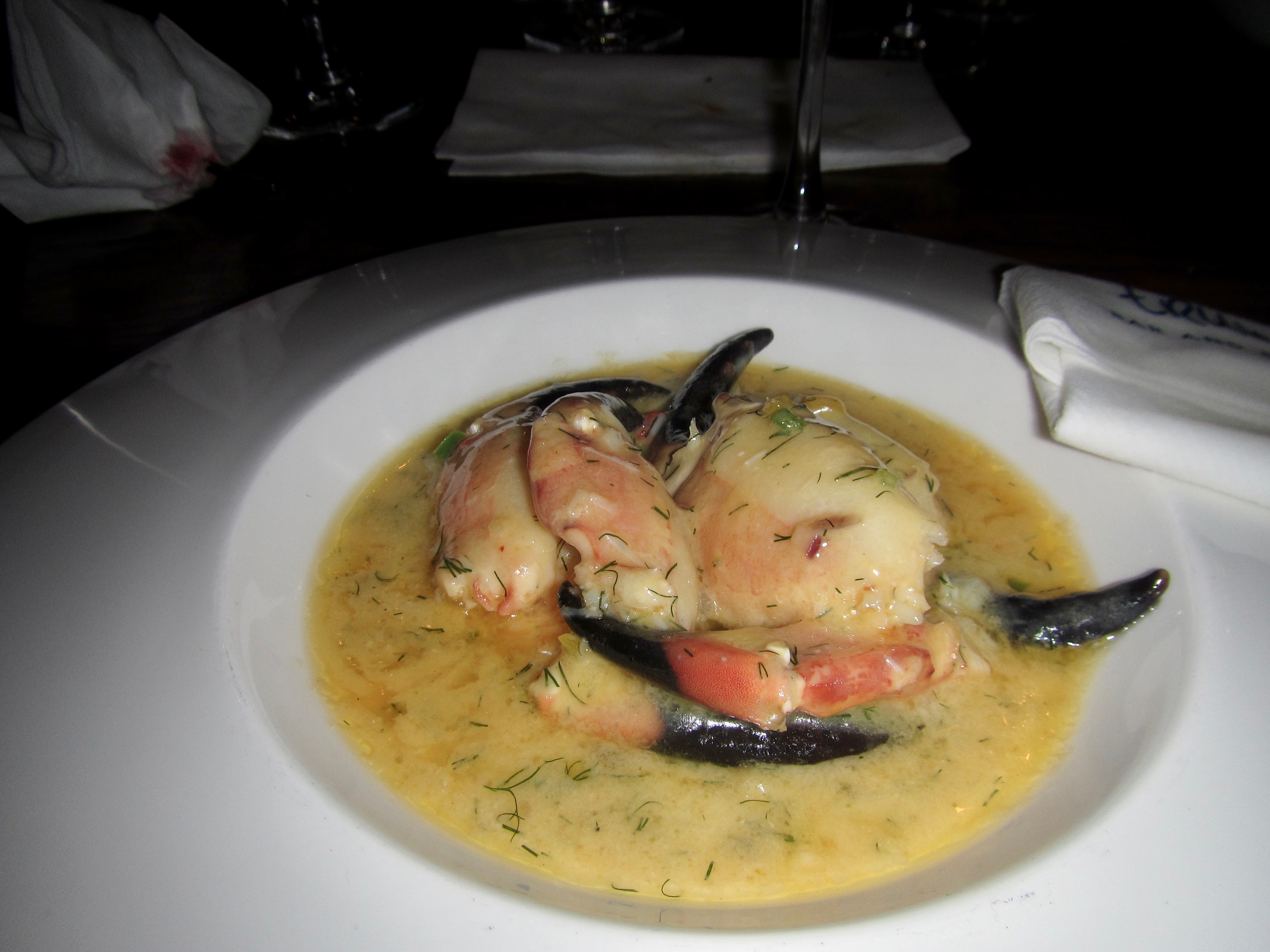
The village of Doonbeg also has some very good restaurants and bars. The meal we had at Morrisseys was superb and featured some very innovative takes on traditional dishes.
What concerns me about Doonbeg is that I don’t think it is sustainable. Given Trump’s belligerence he has pissed off so many people that a lot of European golfers just won’t come here and a few Canadians and Americans as well I suspect. Throw in Covid-19 and I predict the place will have to fold within a year or two. That would be too bad because it does employ 300 people in an area where jobs are scarce and the course is a nice fit with the others in Southwest Ireland.
Next we are off to a completely different type of experience – the K Club in Kildare. Hope to see you there.

